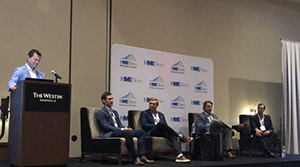Being an early adopter, betting on providers and taking a consultative approach Save the date: Next year's event will be Oct. 22-24 in Charlotte at the Grand Bohemian
By Liz Beaulieu, Editor
Updated 2:52 PM CST, Mon November 7, 2022
 The recent HME News Business Summit, Sept. 18-20 at the Westin in downtown Nashville, Tenn., was the best yet.
The recent HME News Business Summit, Sept. 18-20 at the Westin in downtown Nashville, Tenn., was the best yet.
Here are some snippets from the event that I think are worth highlighting:
On hospital-at-home: Medically Home’s Doug Clarke, formerly of CMS, says the COVID-19 pandemic and the resulting transition of more care to the home has helped to eliminate a number of barriers to adoption. Previously, hospital-at-home didn’t take off at the agency because physicians were concerned with changes to the historical standard of care and didn't have prior experience with high acuity care in the home. The public health emergency that has been in place since the early stages of the pandemic took care of the last two barriers, increasing the model’s adoption. As for the first barrier, Medically Home’s Pete Carlson says early adopters have two things in common: the ability to thin differently and the willingness to make an investment.
On distributors: Medline’s Paul Miller addressed the online resellers in the rear-view mirror of every HME provider. He says Medline is changing its sales strategy with online resellers and that the company is, instead, “betting on providers.” He says online resellers can take orders, make shipments and process returns – but the consumer is looking for additional education and recommendations from providers.
On value-based care: Encore Healthcare’s Zach Gantt says alternative models are “spinning up everywhere overnight.” As a result, the days of “long lists of providers to choose from” are quickly becoming a thing of the past. Providers need to start collecting data and building a story – yesterday – because working with health systems and payers to emphasize the importance of HME in these models is a process. “It’s not a first conversation,” he says, “It’s a third and fourth conversation.”
On the payer perspective: Beth Bierbower, a former sector president at Humana, says it’s now believed 90% of emergency services can be provided in the home, a stat that’s sending payers scurrying to vertically integrate the health care market. “They’re going to go faster and go harder,” she says. But as they get deeper into health care, they’re going to look at partnerships vs. acquisitions, she says. Providers put themselves in the best position by playing a more active role in the contracting process with payers and deepening their relationships with referral sources – particularly primary care physicians – who can serve as their advocates.
The Summit was all of this and more. My hope is attendees left the event feeling as I did – positive about the HME’s future and energized to get back to work.
Comments